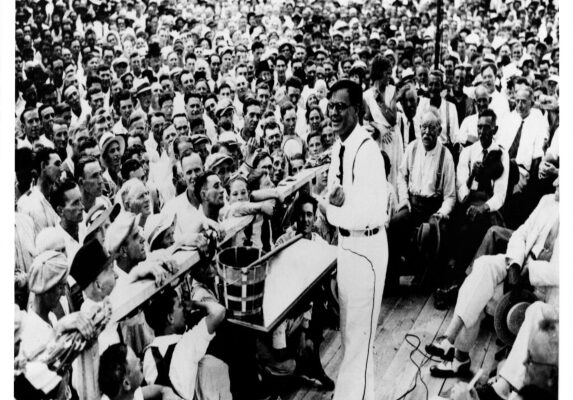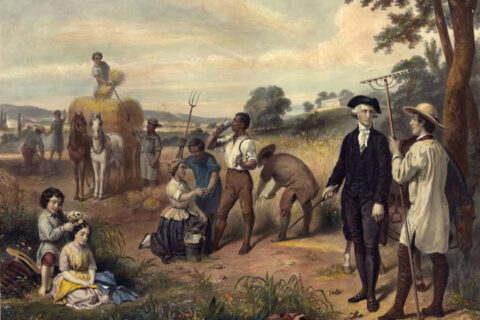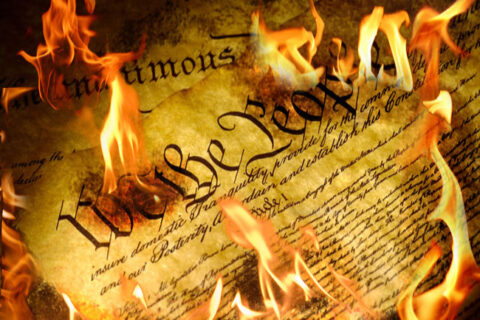Author’s Preface: As we all know, Southern history has been subjected to damnatio memoriae. As such, it is fit that this Southern Separatist website do all it can to preserve all aspects of Dixie's long, storied, and grim history.
The primary source and inspiration for this essay is Origins of the New South by C. Vann Woodward; however, the other sources listed at the end provided additional information as well. This essay was very comprehensive and can seem a bit vague; I cannot recommend Woodward's book enough and highly encourage you to read it.
Fifteen years have gone over the South, and she still sits crushed, wretched, busy displaying and bemoaning her wounds.
Whitelaw Reid in the New York Tribune, 1880
Damnatio memoriae is a Latin phrase which translates to “condemnation of memory.” This is the practice of erasing something from history, typically applied to a person. The phrase, while Latin, does not originate from Rome, despite being an action Romans commonly did, but supposedly originated in a thesis written in Germany in 1689. 21st Century Dixieland finds itself squarely within a macabre cocktail of damnatio memoriae and Neo-Abolitionist historiography it must unwilfully ingest at the behest of the impenitent, loathsome Potomac Regime imperialists and third-world immigrants. Whatever the current Leftist System deems useful history to utilize is subjected to a post-Civil Rights Era filter whilst the rest is erased from history and collective memory. The early Jim Crow and New South Era stands as a testament to this grievous erasure and malicious propaganda, arguably the most butchered period of Southern and American history. There has been a respectable catalogue of works over the years discussing the various historical topics and events of the period, but a sore few books and essays exist providing detailed defenses of the South or its perspective, much less an objective one. A dark, abhorrent, and appallingly bestial period of tumultuous political and societal movements punctuated by the ghosts of the ravaging of scorched earth warfare, social upheaval and inversion, collapse of established shibboleths, iconoclasm, industrialization, Christian Great Awakenings, economic suppression, and abject indigence comprised the early Jim Crow period and directly catalyzed its de jure birth. Commonly used as a moniker for moving Dixie forward into the Gilded Age and modernization of the 20th Century, the “New South” as a descriptor most prominently found usage during this same late-19th Century. This essay will discuss and detail this time between 1877 and 1913 which was the origin and genesis of the Jim Crow Era and the beginning of the New South.
To address the largest elephant in the room for this particular time in history, the beginnings of the Jim Crow era are not as black and white as often purported by the ignorant educated elite of the 21st Century, as stated multiple times in other essays published here. It is the looming shadow over that Southern “dark age” which haunts the era and relegates it to the forgotten aisle in the historic library. A multitude of social movements and changes occurred during this time and were instrumental in the organic development of segregationism and restrictions on voting rights.
The de jure Jim Crow South did not truly begin until 1890 in the state of Mississippi. Rural Southern populism spread like wildfire across Dixie during the 1880’s, a topic of which will be discussed in further detail later in this essay. This virulent populism threatened the stranglehold the corrupt Bourbons held on the indigent Southern states and relegated country folk to the forgotten and unrepresented outskirts and wilderness. Furthermore, these conservative Bourbons utilized and took advantage of the Negro votes, concentrated in the wealthier and more densely populated Black Belt and Lowland counties, to crush the rural Caucasian vote in many parts of the Deep South, with Mississippi, South Carolina, and Louisiana being majority Negro. The planter-patrician paternalism of the antebellum period reappeared in order to win the Negro vote, whom the lowlanders were already socially intimate with, but this was done by these elites in a far more crafty and guileful manner. Mississippi, being the most Negro, also manifested the most unignorably uproarious and acrimonious of grassroots populist movements during the 1880’s. It was also in desperate need of constitutional, social, and economic reform after the overthrow of the Radical Republicans. It was simply impossible for populism to achieve political success without addressing the Negro Question. The outcry for a constitutional convention grew so loud that the Delta Bourbons could no longer ignore it, acquiescing by allowing for a convention. It cannot be stressed enough that the animosity with which the Bourbons viewed lower class Whites is incommunicable.
The 1890 Mississippi Constitution was the true de jure beginning of the Jim Crow era. It was the ratification of that constitution which introduced poll taxes and literacy tests to Dixieland. Between 1890 and 1908, during what came to be known as the next stage Mississippi Plan, the first stage being the end of the Reconstruction era, Southern states drafted and ratified new constitutions which adopted this practice. Unfortunately for the rural White folk, the Bourbons had written a silver lining into these constitutions. The poll taxes and literacy tests also disfranchised many Whites as well. The Bourbons believed they had won by giving the populists what they wanted while also stripping them of many votes. This was ultimately unsuccessful as the populist sentiments only continued to grow throughout the 1890’s, many seeing the sleight of hand for what it was. The fervor and desperation of the populist Whites led to the adoption of Democratic Party White primaries between 1896 and 1906, beginning with South Carolina. After this point, agrarian populism finally flourished across Dixie after decades of campaigning and struggle, leading to the rise of the most prodigious and superlative of statesmen such as Theodore Bilbo, James Vardaman, Eugene Talmadge, Huey Long Jr., Strom Thurmond, Allan Shivers, George Wallace, Richard Russell, and several others.
While the Mississippi Plan got the ball rolling on voting restrictions, segregation of public spaces developed separately. The details for this are a bit fuzzy, some even asserting that segregation was originally a Northern practice and was adopted wholesale by the South. Arguably the primary reason for the development of these social customs arose due to the influx of Nigras and rural and Upland Whites into Southern cities and towns; they already disliked attending school and church together anyhow. Some criers of the New South movement supported it. Before the 1890’s, the South actually had infamously well integrated urban areas that the North often made note of, and the lowland areas saw a remarkably intimate relationship culture between the races. Whatever the case may be, public segregation got its start on train cars in the 1880’s. This phenomenon continued to grow until the Louisiana Separate Car Act of 1890 was challenged by the mixed-race man Homer Plessy. Ultimately, his challenge was brought before the Supreme Court of the United States which ruled in the landmark Plessy v. Ferguson case which ruled public segregation constitutional and established the “separate but equal” precedent. Now solidified by the SCOTUS, segregationists doubled down and continued enacting legislation sell into the 20th Century. This precedent would be a defining pillar of Southern society until 1954 when the Supreme Court overturned its previous ruling on a whim with the Brown v. Board of Education ruling.
With Jim Crow and segregation addressed, it is clear that Dixieland was in the midst of a volatile social situation, its worst since Reconstruction and prior to the Civil Rights Era. As stated previously, there were a number of populist and economic movements which engulfed Dixie between 1877 and the Great War. While it goes without saying, the South was utterly decimated by the War Between the States. Every pillar and shibboleth of its antebellum civilization had been toppled by invasion and military occupation. Simply shedding the shackles of Republican dictatorship was not enough to revive Dixie; it only allowed for the process of rebuilding to occur. Unfortunately, the Redeemer Democrats, later referred to as the Bourbon Democrats, quickly fell into the same corruption and political shenanigans which characterized the Reconstruction Republicans.
In an era characterized by rural indigence and a desperation for political and social reforms, Southerners, especially the rural classes, did not take kindly to this sort of corruption from their own people. This ultimately gave rise to a number of populist movements throughout the 1880’s, 1890’s, and 1900’s. With the exception of excellent men such as Wade Hampton III of South Carolina and a handful of others, the state corruption reared its ugly head with widespread rampancy. Not long after seizing the reins of power, the Bourbons became notorious for the very same malfeasance and duplicity for which Southern voters sent the Republicans fleeing from the South, save for improved spending practices. Overall, their sentiments and policies were wholly uninterested in the lives of the country folk and seldom extended far beyond the densely populated Black Belt.
Generally, this ruling class exhibited the thoughts and behaviors of businessmen and lawyers and were often drawn from their ranks. Immediately following the Redemption, the Black Belt and lowland gentries formed various political machines and rings against poor rural Whites. The antebellum feuds between these classes simply resumed in the late 1870’s from their hiatus during the War and Reconstruction and marked “Solid” South politics until the Civil Rights Era. Even to the exclusion of the insurmountable Negro Question, numerous economic issues provided plenty of weight to the axe which clove Southerners in two. Taxes, interest rates, crop lien laws, the convict-lease system, sharecropping, public school funding, fertilizer inspections, land sales, and railroad expansions all defined the multitude of economic and financial problems with which Dixians bitterly debated and fought each other, spurred on by the uncaring, condescending, and even malicious attitude with which the Bourbons viewed to common Caucasian populace in the Southland the former ruled. These issues and the horrendous state of social life quickly gave rise to the Farmer’s Alliance and agrarian populist movements which dominated the faction rivalries in the Southern Democratic Party during the late 1870’s and 1880’s.
Compounded with these absurd political pursuits, Southern social life was rewritten by the War and Reconstruction. By the close of the 1870’s, Dixie faced a new world and method of living which gave rise to a number of movements and socio-political changes. Financially, Southerners languished in an extreme state of poverty that a 21st Century mind cannot fathom. It was pure indigence, nothing less. This demographic of folks never fully embraced the New South way of thinking, and generally for understandable reasons. The New South had abandoned them and was the way of the businessman, politicians, and middle-class city folk. The era was dominated by a middle-class and business-class of upstarts, arrivistes, and parvenus all wholly at the expense of the poor country folk. As time progressed during the 1880’s, the aforementioned New South adopters were desperately pushing for Yankee investment. They and the banks and corporations sold off everything not bolted down which led to the wholesale and complete ravaging of land in a move which was comparable to that of a strip-mining operation. While railroads were built all across the South, they and the steel industry could never truly flourish because of the discriminatory freight rates enforced by the North and Washington DC.
From these circumstances, grassroots reactionary political and cultural movements arose in opposition. Regarding politics, this manifested as the previously mentioned populist movements. While there were many, the foremost within the South was the Farmer’s Alliance. The Southern Farmer’s Alliance originated in Lampasas County, Texas in 1875 as a means of cooperation between small frontier farmers but also as a way of combatting abuses from large cattle operations, land speculators, cattle kings, and foreign-owned land syndicates. This early organization was tumultuous and frequently split into factions, even ceasing to exist altogether in 1878 but was revived the following year. The Texas Farmer’s Alliance would experience a resurgence in 1886 upon the rise of Dr. Charles Macune through its ranks. Unifying its factions and preventing a split, Macune brokered a merging of the Texas Alliance and the Louisiana Farmer’s Union and renaming the organization the National Farmers’ Alliance and Cooperative Union. This allowed it to further expand into Dixie and advocated for the abolition of national banks and monopolies, free coinage of silver, issuance of paper money, loans on land, establishment of sub-treasuries, income tax acts, and revision of tariffs. The Farmer’s Alliance was not an all encompassing machine of populism within the South, nor did it combat everything poor rural Whites opposed. However, it did successfully get the wheels turning on the succeeding populism of the 1890’s. The Farmer’s Alliance achieved little by its end in 1890, but its impact was magnanimous.
In 1890, fortunes began favoring the populists. While the previously touched on Mississippi Plan in the 1890’s and its legislative proponents did serve the lower classes in their demands to remove the Negro bloc from the controlling whims of the Bourbons and ratify needed improved state constitutions, the means through which voting reforms were accomplished, poll taxes and property requirements, served to disfranchise many Caucasians anyway, negating the desired outcome for the general populace.
Though the 1890’s experienced a resurgence in populism in the South heavily due in part to the Mississippi Plan opening up the façade of its political viability, the Populist Party itself collapsed completely following the presidential election of 1896. That was only one large drop within a sea of populist movements, and many who belonged to that failed party simply moved into the Democratic Party in the South. Nationally and especially below the Mason-Dixon Line, populism and progressivism was saved by the adoption of the direct primaries as a replacement to party conventions, much to the chagrin of state political leadership. For one cause or another, Southern leadership caved to the demands for such. The adoption of the White primaries began in South Carolina in 1896, legalized by the tenure of John Gary Evans, a protégé of former Governor then Senator Ben Tillman who continued Tillman’s agrarian populist policies and presided over the ratification of the South Carolina Constitution of 1896, and was followed by Arkansas in 1897, Georgia in 1898, Florida and Tennessee in 1901, Alabama and Mississippi in 1902, Kentucky and Texas in 1905, Louisiana in 1906, Oklahoma in 1907, Virginia in 1913, and North Carolina in 1915. The age of the populists’ success finally arrived. It was no coincidence that it correlatively rose with the birth of the Jim Crow era and was tied directly to Jim Crowism in 1890 and 1896.
Naturally, these legal reforms gave rise to, or were a direct result of, a slew of reform governors. James Vardaman and Theodore Bilbo of Mississippi, Thomas Campbell and Samuel Lanham of Texas, Charles Aycock of North Carolina, Hoke Smith of Georgia, Jeff Davis of Arkansas, Gary Evans and Cole Blease of South Carolina, and William Goebel of Kentucky were only a handful of the more notable reformers, often champions of segregationism. Jim Hogg was the early 1890’s precursor and influence of Thomas Campbell and Samuel Lanham, and Tillman was a direct influence over that of Gary Evans and Cole Blease.
These governors strove to reform Southern lawfare, combat political corruption, disrupt and weaken state political machines, and improve the lives of farmers and industrial workers. The railroads and their benefactors were arguably the primary opponent of these reformers, and it was not long before they started cracking down on the industry, one of the most popular means of which was railroad commissions. Railroads had themselves to blame due to their habits of discrimination, rebates, stock manipulation, favoritism, and overcharging; additionally, they would blatantly discriminate against states which passed laws or had railroad commissions they did not approve of, such as Texas and Georgia. Uniquely, anti-monopolization of the big oil companies in Texas was a major part of the movement there. Even insurance companies made it into the crosshairs for a time. Other strides were made to better fund public education and end child labor laws as well as the convict-lease system. One of the most successful members of this breed of governor was the uproarious Bilbo, who accomplished the creation of a state tax commission and the equalization of tax assessments, a board of bank examiners, a highway commission, a pardoning board, a tuberculosis hospital, a charity hospital, a training school for the unruly, a compulsory school-attendance law, a Blue Sky law, a stringent anti-lobby law, equalization of school fund distribution, adult night classes, and the most sizeable appropriation for education the state had seen at the time. Ultimately, these movements achieved a goodly amount of success compared to previous efforts, but populism eventually began falling out of vogue during the Great War and devolved largely into campaigns of racialism. Southern populism reared its mighty and acrimonious head again in 1954 following the Brown v Board of Education ruling as a means of massive resistance to forced integration at the point of bayonet. Fortunately, old-school agrarian populism finally made some much needed reforms to Southern society before it dissipated and World War I brought the New South era to a close.
Culturally, Southern Whites further developed their sense of identity while Christian revivalism surged. While a cosmopolitan call for progress and Yankeefication did occur from the late 1870’s to the turn of the century alongside a major push for industrialization, the average Southerner rejected the idea. Dixie became engulfed in the nostalgic mindset of Lost Cause historiography, grace and gallantry, veterans’ reunions, genealogy, and literature. The macabre brutality and poverty of invasion and Reconstruction served as a unifying force for Southern identity and breathed life into the people’s resolve and culture. Country life still clung to many of the customs of the antebellum period and the Old Order, of which the previously mentioned belonged. Industrialization failed to take root, and Southerners remained mostly rural until after World War II, lend further weight and longevity to these old ways and customs.
Christianity continued to spread ravenously across Dixieland. While Christendom’s spread was nothing new to the South due to the 2nd Great Awakening and the Confederate Army revivals, this new wave of Christian zeal carried with it an unforeseen zeal in the region; compounding generations of hard times drew folks closer to God and made them more willing to receive Christ. By the 1880’s, Baptists and Methodists were the leading denominations across the South, having overtaken the previously dominant Presbyterians and Episcopalians. The fervid Protestantism of the time tended to openly oppose the progressivism of the New South mantra and became positively symbiotic with the Lost Cause and Southern identity, deepening the rift between Northern and Southern denominations. Reverend Robert Lewis Dabney himself even brazenly spoke out against the new age in an address titled “The New South.” This facet of Southern culture became a mainstay of its history and social customs even into the 21st Century and was a monumental pillar in preserving its uniqueness among the various nations of the world.
However, not every aspect of late 19th Century culture was positive. Violence pervaded and grew with intensity during the New South era. The long-established culture of violence in the South grew so wanton that even historian C. Vann Woodward claimed, “The South seems to have been one of the most violent communities in comparable size in all Christendom.” Education, as well as the arts and sciences, were woefully lacking, and few general improvements were made for rural folk until populism finally succeeded at the turn of the century. Bleakness was a mainstay of life.
A densely packed and tempestuous period within Southern history all but wholly forgotten by 21st Century America, it is difficult to summarize within the span of a single essay. This dismal, violent period did fortunately come to a close in 1913, but the next stage of American society did not heal Dixie’s wounds. While Woodrow Wilson did reintroduce the South to the national stage for the first time since 1865, the emergence did not bring to the South the prosperity and peace many within it desired. However, the darkness of the New South period and its beginnings did succeed in establish a stringent social order and flourishing of Christianity which it so desperately needed. This period, though grim, was an integral part of Southern identity and much more within it occurred than simply the passage of Jim Crow laws, necessitating its preservation and study.
Bibliography:
Kirwan, Albert D. Revolt of the Rednecks: Mississippi Politics 1876-1925. Lexington, KY: The University Press of Kentucky, 1951.
Morgan, Chester M. Redneck Liberal: Theodore G. Bilbo and the New Deal. Louisiana State University Press, 1985.
Percy, William Alexander. Lanterns on the Levee: Recollections of a Planter’s Son. Baton Rouge, LA: Louisiana State University Press, 2006.
Trotter, Jack. “The Strange Career of Segregation.” Abbeville Institute. Last modified April 1, 2020. Accessed January 30, 2022. https://www.abbevilleinstitute.org/the-strange-career-of-segregation/.
Woodward, C. Vann. Origins of the New South: 1877-1913. Edited by Charles B. Dew, Wendell Holmes Stephenson, and E. Merton Coulter. Baton Rouge, LA: Louisiana State University Press, 1971.
Woodward, C. Vann, and William S. McFeely. The Strange Career of Jim Crow. Oxford: Oxford University Press, 2002.
Other essays of mine regarding these topics:
A Defense of Jim Crow and the South
“The White people of the South are the greatest minority in this nation. They deserve consideration and understanding instead of the persecution of twisted propaganda.” –Strom Thurmond






Great article Sir.
I would like to share from a book that I am reading right now, ‘Salvation on Sand mountain’, by a Southerner named Dennis Covington. P. 88
‘ shortly after the turn of the twentieth century, these descendants of fierce Scotch-irish immigrants awoke from their sojourn in the mountains to face the bitter reality of an industrialized and secularized society. Their sense of purposeful labor was eroded in the mines and factories. Their formerly close-knit families fractured. And they confronted a largely urban culture that appeared to have lost its concept of the sacred. The hill people had awoken to discover that the new Eden they’d inherited was doomed —- mechanized and despoiled beyond recognition —- and that they were lost in the very heart of it.’
Prologue.
……’I’m talking about the long, slow burning fire, the original civil war and the industrialization that it spawned. I’m talking about the colonization of the South by northern entrepreneurs. I’m talking about the migrations to the cities, the cholera epidemics, the floods. I’m talking about the wars Southerners fought disproportionately in this century, the poverty they endured. I’m talking about our fall from Grace. I’m talking about the scorn and ridicule the nation has heaped on poor Southern Whites, the only ethnic group in America not permitted to have a history……
God Save the Southland!
Edit.
That book i shared ended up being more Southern White guilt garbage towards the end. I should have known better when he called the carpetbaggers northern entrepreneurs. Quit reading it. It was really good up to that point.
Aight I won’t read it then haha
It really is a good read to see how the different expressions of Southern Christian religions evolved right up to snake handling, this is my favorite paragraph in the book:
One night in East Tennesee , a snake handling preacher came up to us and said, ” you boys got any snakes in that car?”
We told him we didnt.
What? You mean to tell me you don’t have any rattlesnakes in your car?”
“No Sir”
His eyes widened. “What’s the matter with you boys?”
He said “are you crazy?”
I do recommend this book, the ending is garbage in my opinion.
I will try to obtain that book you recommended.
‘The populist revolt’ by Hicks is really good also.
God Bless you Sir, I felt I made a mistake commenting on your excellent article, I’m glad you took it in good humor.
It’s all good. I appreciate the enthusiasm and commentary on my history essays. The essays are laborious and time consuming to research and write. It’s nice to know that people actually read them.
https://identitydixie.com/2020/04/30/damnatio-memorae-for-the-21st-century/
I’ve not read that article. Thank you for sharing it.